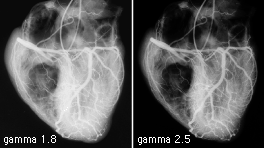Gamma
In computer imaging and display screens "gamma" refers to the degree of contrast between the midlevel gray values of an image. The technical explanations of gamma are irrelevant here — the visual effect of changing gamma values is easy to see. If you own a copy of Adobe ImageReady, open an image with an average range of colors and contrasts and use the "Image: Adjust: Gamma" control to change the gamma settings (see the ImageReady manual for details). Images will change noticeably with even minor changes in gamma settings. Gamma considerations are particularly important if you are displaying images with very long gray scales (such as medical diagnostic images and fine black-and-white photography) or images in which the exact color values are critical (such as works of art and clinical medical photographs):

The default gamma settings for Macintosh (1.8 target gamma) and Windows (2.2 target gamma) monitors are quite different, and this can lead to unpleasant surprises when you first see your images displayed on "the other" platform. Mac users will see darker and more contrasting images on Windows displays; Windows users will see flat and washed-out images on Mac displays. Most Web designers opt for a middle-ground solution, lightening images slightly if they work on the Macintosh; darkening slightly and adding a little contrast if they work in Windows.
| 